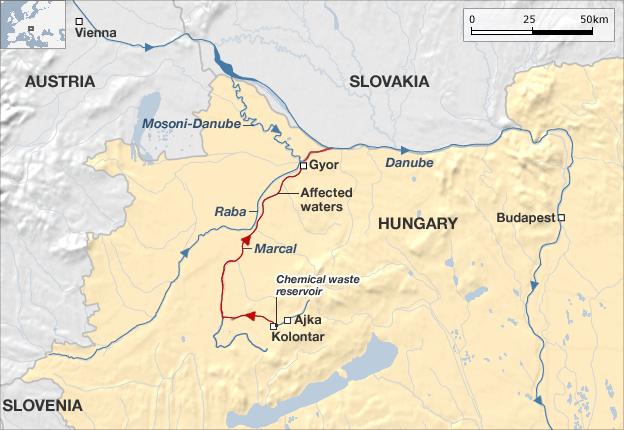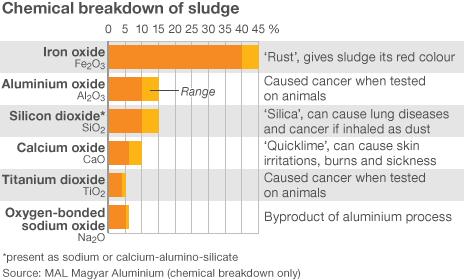Hungary calms Danube sludge fears as death toll rises
- Published
The BBC's Duncan Kennedy: "The mud is all around. You can't escape it"
Hungary's prime minister has played down the threat of widespread pollution to the River Danube, following the spill of a large amount of toxic red sludge from an industrial plant.
Viktor Orban said the situation had been brought "under control".
However, officials remained concerned that toxins from the drying sludge could be spread through the air.
The death toll from the disaster rose to seven on Friday, after rescue personnel discovered two more bodies.
Rescue agency spokesman Tibor Dobson says the unidentified victims were found near Devecser, but were most likely residents missing from the nearby town of Kolontar.
Up to one million cubic metres (35m cu ft) of sludge is estimated to have flooded from a burst reservoir at an alumina plant in Ajka, western Hungary, on Monday, destroying homes and pouring into rivers which feed the Danube.
The alkaline sludge reached the Danube on Thursday, with emergency workers pouring huge quantities of clay and acid into streams to neutralise it.
The chief of Hungary's disaster relief services, Tibor Dobson, told Reuters news agency that fresh data showed pollution levels had fallen in the Danube.
He said the alkali level on Friday was at pH8-8.2, down from pH9 when the pollution reached the river.
Water is pH7 when neutral, with the safety levels ranging from pH6.5 to pH8.5.
"This data gives us hope... and we have not experienced any damage on the main Danube so far," he said.
Mr Orban, visiting Bulgaria, said: "The good news is that we have succeeded in bringing it under control and very probably waters threatening the environment will not enter the Danube, even on Hungarian territory.
"We managed to take control of the situation in time."
Interior Minister Sandor Pinter said the Danube was no longer at risk of biological or environmental damage.
"Let's not even consider the pollution that got into the Danube as real pollution now, as the material that got into the river has pH levels of below 9, which, considering the [large volume of] water, will dilute in a few kilometres," he told a news conference.
He added that the spill had not affected drinking water supplies so far.
Meanwhile, Hungary has asked the EU for urgent help in dealing with the disaster.
In activating the EU Civil Protection Mechanism, Hungary is asking for three to five experts with experience in environmental damage and neutralising toxic mud, an EU statement said, external.
Kristalina Georgieva, EU Commissioner for Crisis Response, added: "Disasters like this do not stop at national borders and a combined European response can help deliver the most effective assistance possible."
However, the BBC's Duncan Kennedy in Hungary says there is an additional concern - the weather.
Recent days of rain have kept the sludge wet and officials now fear that warmer and sunnier weather will create dust that could spread toxins - and possibly low-level radioactive materials - into the atmosphere.

If that happens, our correspondent says, the authorities will have to decide whether to evacuate more areas.
Environment Minister Zoltan Illes confirmed that the sludge - which now covers a 41 sq km (16 sq mile) area - had a "high content of heavy metals", including carcinogens.
"If that [were to] dry out then the wind can blow that heavy metal contamination through the respiratory system," he said.
The company responsible for the alumina plant, MAL Hungarian Aluminium Production and Trade Company, has offered its condolences to the families of the bereaved but insisted it had done nothing wrong.
It said it was devoting "all its energies and efforts" to tackling the spill.
The firm says it has released 110,000 euros ($150,000) so far to help with the clean-up.
'Ecological tragedy'
The mud has caused massive damage to Hungarian villages and towns close to the plant, as well as a wide swathe of farmland.
Mr Dobson said all life in the Marcal river, which feeds the Danube, had been "extinguished".

Those who lost their lives were believed to have drowned, with the depth of the fast-moving flood reaching 2m (6.5ft) in places, but many of those injured suffered chemical burns.
Greenpeace International said on Friday it was worried at the levels of arsenic and mercury in the sludge.
Spokesman Herwit Schuster said: "We found levels of arsenic, mercury and chrome and the arsenic level especially was double what we expected, double what is usually contained in such red sludge."
- Published7 October 2010
- Published8 October 2010
- Published6 October 2010
- Published5 October 2010